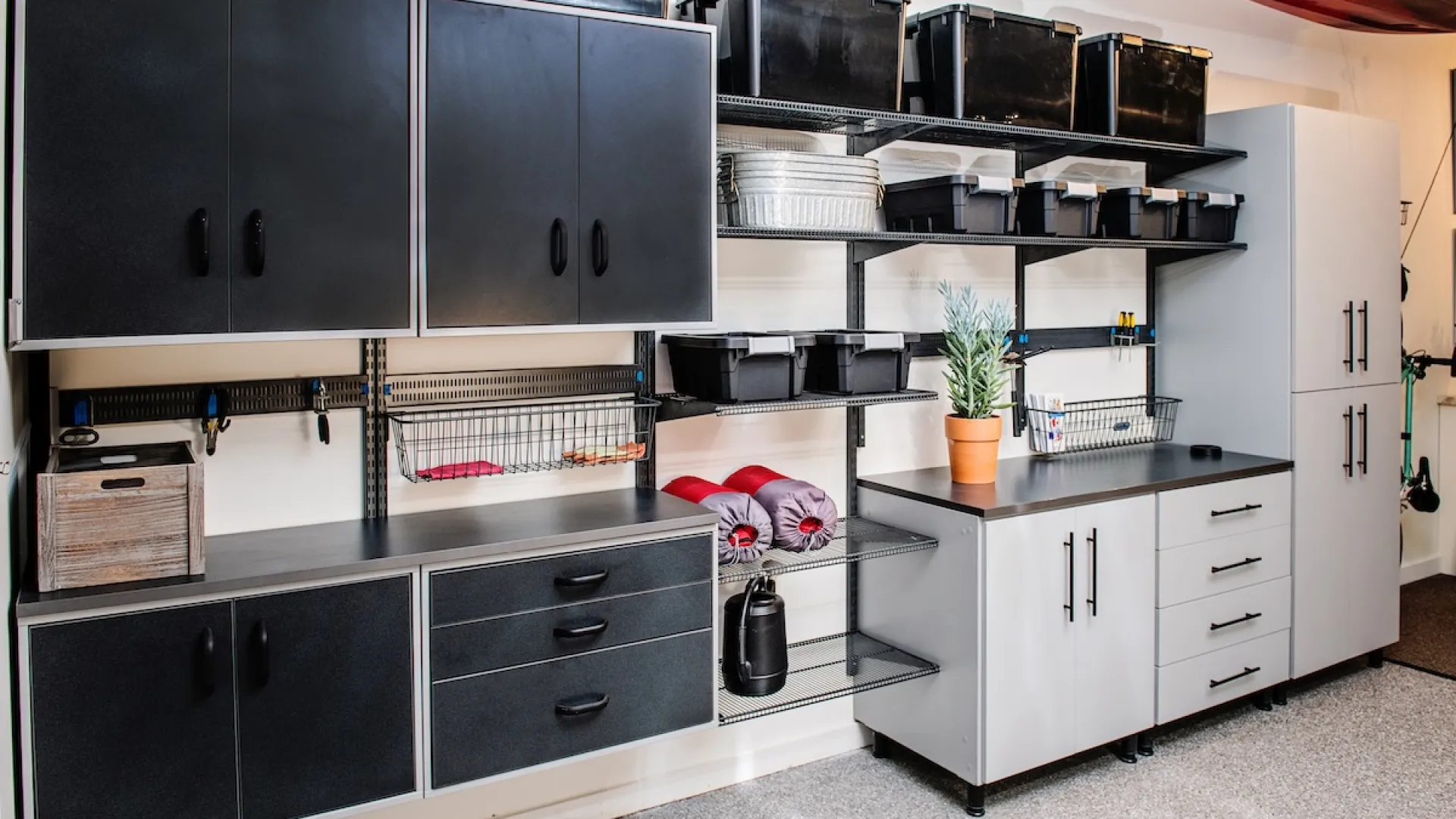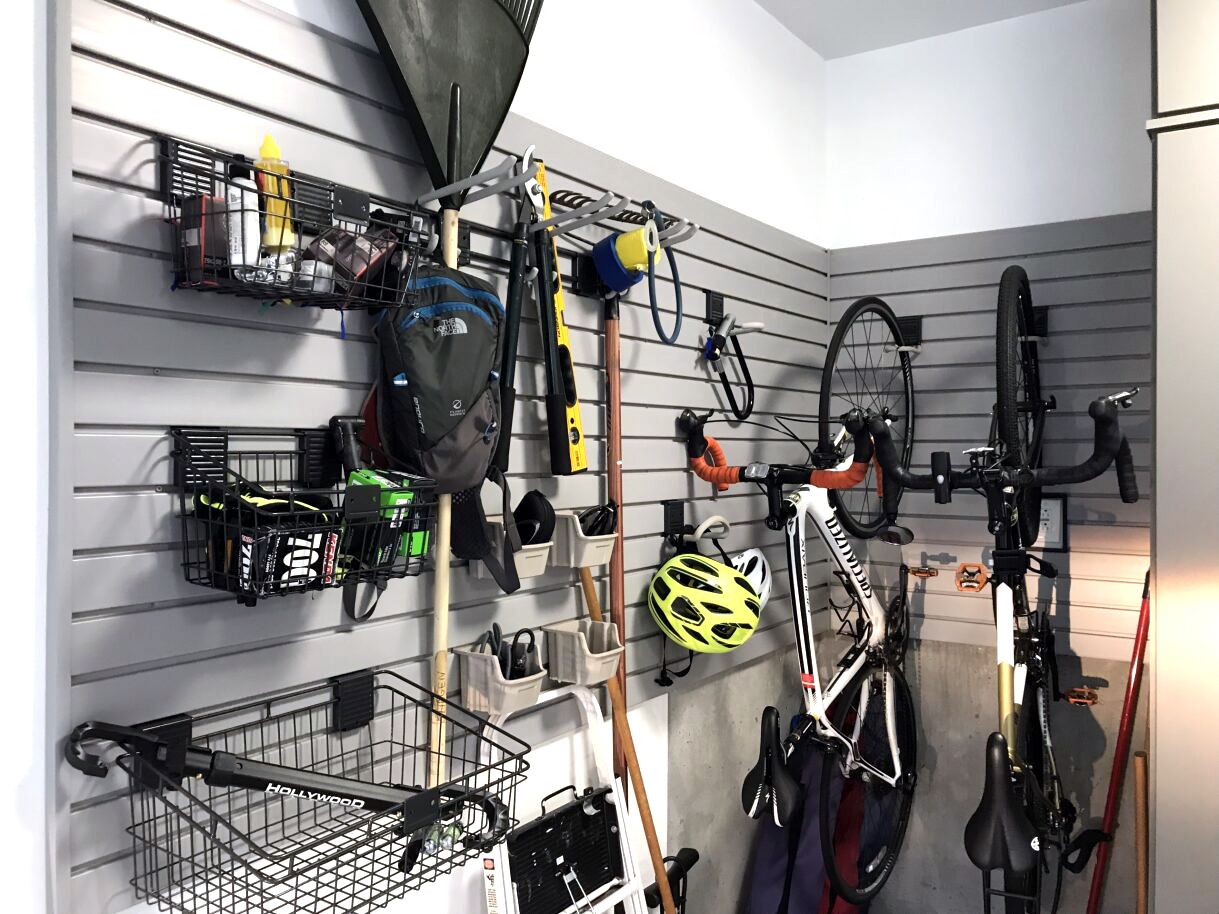
How to Achieve Perfect Garage Organization in 5 Simple Steps
A well-organized garage does more than hold your tools — it transforms the way you work, relax, and connect with your projects and storage. The garage has evolved from a forgotten corner of the home into an essential part of the home's rhythm, offering storage, workspace, and even a little serenity.
Yet for many homeowners, it becomes a catch-all for life's supplies, half-finished projects, and tools that never seem to have a home. If you've ever stepped into your garage and felt a wave of overwhelm, you're not alone. The good news? With a little planning and thoughtful design, perfect garage organization is entirely within reach.
Organizing your garage isn't about perfection; it's about purpose. Every hook, bin, and shelf should make your space more functional — and more enjoyable to use. Whether you're a weekend gardener, car enthusiast, large family, or seasoned DIYer, a well-planned garage allows you to work more efficiently, protect your tools, and restore a sense of calm to your surroundings.
This guide walks through five simple, achievable storage ideas to transform your garage into a beautifully organized space — one that feels as inviting as it is practical.
Step 1: Assess Your Garage Needs
Every great organization project begins with understanding how you use your space. Before you start stacking bins or hanging tools, pause to take a closer look at what's inside your garage — and what you actually need it to do.
The goal of this step is clarity. Think of it as decluttering your routine before decluttering your shelves. When you define your purpose, every decision that follows becomes easier.
Start by completely emptying your garage. It may seem like a daunting task, but removing everything allows you to see the true potential of the space. As you pull items out, sort them into clear categories: keep, repair, donate, and discard. Be honest — if you haven't used it in a year, it's time to let it go.
Once the space is empty, take a moment to observe. Notice natural light sources, ceiling height, and any unused corners. Jot down what works and what doesn't.
Ask yourself:
Do you use this garage primarily for gardening, storage, or projects?
Which items do you reach for most often?
Are there tools or supplies you'd like easier access to?
Is your garage finished or unfinished, and do you need additional protection for sensitive materials?
When you understand your garage's purpose, you can design a layout that supports it — turning a cluttered space into a functional retreat.
Identify Items to Store
With your garage cleared, it's time to decide what belongs back inside. This is where garage organization truly begins. Take inventory of what you have, grouping items by category and function.
Typical garage essentials include:
Overflow storage like extra paper products, cleaning supplies, and appliances.
Power tools such as drills, saws, or sanders.
Lawn care supplies, including fertilizer, weed control, and hoses.
DIY materials like nails, screws, and wood.
Outdoor décor or patio accessories.
Seasonal items such as holiday decorations or pool gear.
As you group these items, visualize how often you use each. Items used daily — garden gloves, basic tools, home suppliesl — should live front and center. Seasonal items can be stored higher up or deeper in your garage's corners. This approach makes maintenance effortless and saves time each time you step inside.
Determine Frequency of Use
Frequency is the key to efficiency. Garage organization works best when the most-used items are within easy reach and seldom-used supplies stay neatly tucked away.
Here's a simple guide to help you map placement:
Daily or weekly use: Place on open shelves or hooks near the entrance.
Monthly use: Store on mid-level shelving or in clear bins.
Seasonal use: Keep on higher shelves or in the back of the garage.
By arranging your garage according to how you use it, you'll avoid the frustration of searching and make tidying up second nature.
Step 2: Create a Storage Plan
Now that you know what you're keeping and how you'll use it, it's time to plan the layout. A smart storage plan is the foundation of garage organization — it gives every item a home while keeping the space open and inviting.
Begin by sketching a quick layout of your garage. Note door, window placement, and wall studs that can support shelving. The goal is to create zones that make sense for your lifestyle.
Choose Your Storage Systems Wisely
When it comes to garage organization, one size doesn't fit all. Your tools, supplies, and hobbies all deserve storage solutions that truly fit their purpose.
Consider these ideas:
Shelving units: Perfect for bins, boxes, and power tools.
Hooks and wall racks: Ideal for rakes, shovels, cords, or hoses.
Pegboards and wall tool holders: Keep smaller tools visible and easy to grab.
Storage bins: Use for garden seeds, nails, or small parts.
Match each system to the items it holds — for example, deep shelves for power tools and narrow racks for hand tools. Think about accessibility too: you don't want to balance on tiptoe to grab the item you use most often.
If you store hazardous materials or chemicals, include ventilated cabinetry to protect against fumes. Durable, moisture-resistant materials are essential, especially in Southern climates where humidity is high.
Designate Zones for Different Categories

A zoned layout turns chaos into clarity. Divide your garage into areas based on function, much like a well-designed kitchen or workshop.
For instance:
Tool Zone: Hand tools, power tools, chargers, and safety gear.
Garden Zone: Pots, soil, fertilizers, and gloves.
Seasonal Zone: Decorations, patio cushions, or outdoor lights.
Utility Zone: Cleaning products, repair kits, and household extras.
Label these areas clearly, either with signage or color coding. When every item has a designated zone, your garage will stay organized long-term, even after a busy weekend of yard work.
Plan for Movement and Safety
It's tempting to maximize storage, but space to move (and park your car again!) matters just as much. Leave clear walkways so you can reach any corner of your space without climbing over bins.
Store heavier items lower to prevent injury and keep sharp tools at a safe height. For added comfort, consider adding a small mat at the entry points to prevent dirt from spreading indoors, especially useful for gardeners. Good lighting also improves safety and usability.
Step 3: Implement Garage Storage Ideas
With your plan in place, it's time to bring your ideas to life. Installing shelves, racks, and hooks will make your garage organization system both functional and beautiful.
Start with your walls: they're your most valuable real estate. Vertical storage keeps your floor clear and your tools within easy reach.
Install Shelves and Hooks
Sturdy shelves provide structure. When seeking garage shelving solutions, opt for durable wood or powder-coated metal, depending on your garage's climate exposure. Adjustable shelving lets you accommodate everything from small bins to large containers.
Hooks are equally essential for maximizing vertical space. Use heavy-duty hooks for long-handled tools and lighter hooks for smaller items like gloves or hats.
Pro Tip: Place frequently used tools at chest height for easy access, and mount rarely used items higher up.
And here's a garage organization tip: If your garage has a workbench, add a pegboard directly above it. Pegboards are versatile, allowing you to rearrange tools as your projects evolve. Add small containers or magnetized strips to hold bits, blades, or fasteners neatly in place.
Utilize Vertical Space
The secret to efficient garage organization lies in thinking upward. When floor space is limited, your walls (and even your ceiling!) become valuable storage opportunities.
Try these vertical strategies:
Tall shelving units: Store boxes, bulk soil, or seed trays.
Overhead ceiling racks: Ideal for lightweight or seasonal gear.
Magnetic strips: Keep metal tools visible and organized.
Pegboards: Perfect for hand tools and accessories.
This approach keeps your floor open for large items like wheelbarrows or mowers while maintaining a streamlined look.
Design Note: Paint or stain your shelves to match the garage's walls for a polished, cohesive appearance — a simple detail that makes the space feel intentional.
Incorporate Multi-Purpose Solutions
To organize small garages or multi-use spaces, versatility is key. Choose pieces that serve more than one purpose, like a storage bench that doubles as seating or a fold-down table for potting plants.
Compact shelving with baskets, or modular units that can expand over time, adapt easily to changing storage needs. The best systems grow with you.
Step 4: Optimize for Garage Organization
Organize for how you'll be using your garage. If your garage serves as a gardening headquarters, for example, proper organization means your trowel, gloves, and potting mix are always within reach, and your space stays clean, bright, and safe.
Create Dedicated Zones
A garage that functions as a space for multiple purposes, like storage, projects, and housework should have a clearly defined rhythm. Begin by setting work zones near natural light if possible. Keep your bench or folding table here, along with the material you need for what you do most.
As mentioned, store small hand tools on a pegboard or magnetic strip above your bench. Larger tools, like saws, shop vacs, shovels, and rakes, can hang neatly on wall hooks. This keeps them visible but out of the way, reducing clutter and preventing accidents.
Design Tip: Line a single wall with open shelving made of moisture-resistant wood or coated metal. Place attractive baskets or labeled bins. The result is a workspace that feels intentional and inspiring.
Separate Tools and Supplies
Mixing chemicals or fertilizers with daily-use items can be risky. Dedicate a closed cabinet or tall locker for anything potentially hazardous. Add ventilation or keep it slightly raised off the floor to prevent moisture buildup.
Group your tools by type for efficiency, and hang the most frequently used tools at eye level, while seasonal equipment can sit higher up. This system keeps your garage organization intuitive: you'll know exactly where to reach every time.
Use Clear Bins for Visibility
When you can see what you own, you save time. Clear plastic or acrylic bins are perfect for storing small items, like screws and nails, bulbs, or gloves. Label each bin clearly with waterproof tags and stack them by frequency of use.
For example:
Daily Use: gloves, basic tools, scissors.
Monthly Use: fertilizers, pest control sprays, power tools.
Seasonal Use: holiday décor, seasonal sporting equipment.
Ask any pro organizer: The best way to organize a garage is with transparent containers. They not only simplify retrieval but also add a clean, modern aesthetic: something that complements the refined look of a thoughtfully-designed home.
Step 5: Maintain Your Garage Organization
A perfectly organized garage won't stay that way on its own. The final step, maintenance, is about creating simple habits that preserve your hard work and keep your garage running smoothly all year long.
Set a Regular Schedule
Think of garage maintenance as part of your seasonal rhythm. After spring cleaning, summer projects, or fall cleanup, dedicate an hour to returning everything to its place. Sweep floors, wipe surfaces, and check for leaks or pests.
Schedule a quarterly deep-clean:
Empty and dust shelves.
Re-label any faded tags.
Inspect for rust or wear.
Sharpen tools and oil hinges.
Establishing this schedule ensures your garage organization system continues to function beautifully, year after year.
Keep a Checklist
A master checklist turns maintenance into a habit instead of a chore. Tape a laminated copy inside your garage or keep a digital version on your phone.
Include sections like:
Essential garden tools and hardware.
Lawn-care products and cleaning supplies.
Safety equipment and gloves.
Seasonal décor, sporting equipment, or maintenance items.
Revisit your list at the start of each season. If something is broken or rarely used, remove it, or move it to the basement. A simple review prevents clutter from creeping back in — the silent enemy of every garage.
Refresh Your Organization System Seasonally
As your projects evolve, so should your storage. The setup that works in spring might not suit winter's needs. Adjust shelf heights, rotate bins, and re-evaluate your zones.
In summer, prioritize gardening supplies; in winter, move snow shovels or holiday décor to the forefront. Regular adjustments keep your garage organization ideas flexible and responsive.
Design Note: Small seasonal touches, like swapping out baskets for wooden crates or adding a sprig of greenery, make your garage feel as curated as any room in your home.
Encourage Shared Responsibility
If others in your household use the garage, involve them in the system. Assign each family member a labeled bin or hook. Clear, consistent organization works best when everyone plays a part.
Adding a chalkboard or whiteboard near the door is a simple way to track ongoing projects or tools that need maintenance. It also reinforces accountability and makes organization feel collaborative.
A Well-Organized Garage Inspires Productivity
A garage isn't merely a storage space; it's a reflection of how you approach your home and projects. A thoughtfully organized garage radiates calm and capability: a space where inspiration and efficiency coexist.
When every item has its place and every zone serves a purpose, you'll notice the difference instantly:
Projects start faster and finish smoother.
Tools last longer and stay cleaner.
Outdoor chores become more enjoyable.
It's the kind of subtle transformation that improves your daily rhythm: turning a once-cluttered corner into an integral part of your lifestyle.
Bringing It All Together
Perfect garage organization doesn't happen overnight, but it doesn't require perfection either. It's about designing a system that reflects you: your habits, your tools, and your goals.
To recap the five steps:
Assess Your Needs: Understand what you have and how you use it.
Create a Storage Plan: Give every item a home that makes sense.
Implement Storage Ideas: Mix shelves, hooks, and bins for balance.
Optimize for Garage Organization: Design zones that make indoor and outdoor work effortless.
Maintain Your System: Keep up regular care and adjustments.
When done thoughtfully, these steps turn your garage into an organized retreat that supports your creativity, efficiency, and peace of mind.
Design Inspiration: Elevating Everyday Spaces
In many ways, organizing your garage mirrors the art of designing your home. The same principles apply: balance, flow, and function. Consider your garage an extension of your home's design language.
A coordinated color palette, well-chosen materials, and streamlined hardware can make even the most utilitarian garage feel intentional. Matte finishes, soft neutrals, or a pop of deep green or navy can harmonize with your home's exterior.
Lighting also makes a difference. A single pendant or soft LED strip adds both style and practicality, making evening projects easier and enhancing the overall atmosphere.
Pro Tip: Add a small potted plant or hanging fern near the entrance. A touch of life will bridge your indoor and outdoor worlds beautifully.
The Beauty of Simplicity
True organization isn't about creating complexity; it's about simplifying. A clean, functional garage restores clarity to your routines and invites creativity into your daily tasks. It becomes a space that motivates you to start and finish projects with ease.
Even in the midst of Metro Chattanooga's changing seasons — from humid summers to crisp fall afternoons — your organized garage stands ready, calm, and efficient. With everything in its place, you gain more than space; you gain peace of mind.
So roll up your sleeves, sketch your plan, and reclaim your garage. With these five simple steps, you'll not only achieve perfect garage organization, you'll elevate your everyday life.
Ready to bring structure and style to your garage? Schedule your complimentary design consultation today, and see how custom storage transforms your everyday into something beautiful.


